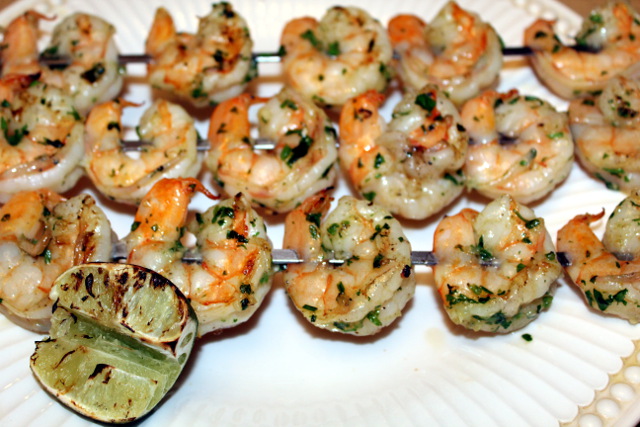How to Grill Shrimp
Knowing how to grill shrimp is a skill you want to have.
Shrimp are tasty and loved by lots of people.
Grilling them makes 'em even better!
A lot of people are intimidated by grilling shrimp.
Don't worry, I'll show you how to grill shrimp that's tasty, moist and has the right texture.
No tough, rubbery shrimp here.
It isn't that hard, the key is picking the right shrimp and not overcooking them.
How to Pick Shrimp for Grilling
An important element for great grilled shrimp is the size of the shrimp.
You want big shrimp...
When you go shopping for shrimp you'll see labels like small, large, jumbo, etc.
These terms are kind of vague and aren't regulated.
What you want to know are the number of shrimp per pound; the smaller the number, the bigger the shrimp.
For example; When the label says 26/30, you'll get 26 to 30 shrimp per pound. If the label says 16/20, you'll get 16 to 20 shrimp per pound.
For grilling, you want shrimp labeled U/15. This means there's under 15 shrimp per pound. You can use bigger shrimp, remember to adjust your recipe for a minute or two longer cook time, depending on the size of the shrimp...
The reasons you want big shrimp for grilling;
- Big shrimp take longer to cook. This means you can get a nice char on them before they overcook.
- Because they're bigger, they're less prone to drying out.
- There's less prep work. Cleaning, seasoning, skewering and cooking 30 shrimp is less work than doing the same to 60 shrimp.
- It's impressive! Bringing those skewers in from the grilled loaded up with giant shrimp looks good.
What's Best for Grilling, Fresh or Frozen Shrimp?
When you go shrimp hunting at your grocery store or fish market, you'll find "fresh" and frozen shrimp.
I'm about to tell you something that will insure you enjoy great shrimp for the rest of your life...
And I'm happy to do so.
All shrimp have been frozen.
Yes even the fresh shrimp in the seafood section of your grocery store have been iced over, then put in the deep freeze. Your grocer thaws them out and puts them on display.
When shrimp are harvested, they're iced on the ship at once. This freezes the shrimp. The shrimp are held this way until they reach the market.
This process helps to prevent the shrimp from spoiling and preserves the natural briny flavor of the shrimp.
You can buy live shrimp at some fish markets and Asian grocery stores.
But, unless you see the shrimp you're about to buy swimming in a tank, or jumping around in a basket, it's been in the deep freeze at some point.
What does this mean to you?
Since shrimp are prone to spoilage, and the "fresh" shrimp is actually frozen shrimp that has been thawed...
You're best bet is to go with the frozen shrimp.
Why?
- The shelf life for fresh shrimp is 1-2 days. Thawed shrimp is about to go bad in a day or two. Buy it frozen and thaw it yourself.
- It's more convenient. You can buy the shrimp, defrost it overnight, or in about five minutes. (I'll show you how) You're not under the gun to cook it before it goes bad.
- You'll get better flavor and texture. The methods used to individually quick freeze shrimp help it keep its natural flavor and texture. Remember, shrimp is highly perishable. Shrimp eaten soon after harvest tastes better. Individually quick freezing shrimp helps to preserve its fresh flavor.
Of course, if you can buy live shrimp, this is the way to go. If not, go for the shrimp in your freezer section.
You'll be much happier with the results.
Shrimp With Shells on or Off?
When you go shrimp shopping, you'll find shrimp with and without the shells...
Which ones should you choose?
Opinions vary on the subject;
Some say cooking the shrimp with the shell on helps to keep them from drying out.
Others will tell you that as soon as you peel the shrimp all the seasoning comes off with the shell.
But if you season the shrimp well, the seasoning will be on your fingers, then get transferred to the shrimp as you eat them.
Well I don't want to peel a bunch of shrimp, I wanna eat!
What to do?
To be honest with you, I have zero experience cooking shrimp with the shells on.
I've cooked shrimp without the shells in every restaurant I've ever worked in.
Now keep in mind, these were high end restaurants that would never dream of making the customer peel shrimp.
Everything was prepared to make the meal easy to eat.
That's what we do in fancy restaurants. The thinking is that easier is more enjoyable. There's also a sense of refinement when food is served this way.
The guests experience is as important as the food.
In this recipe for how to grill shrimp, we will be grilling peeled and de-veined shrimp.
How to Peel and De-vein Shrimp
If you buy shrimp with the shells on, you'll want to peel and de-vein them for this recipe on how to grill shrimp.
Don't worry, it's easy.
First, if the shrimp are frozen, you'll need to defrost them.
The preferred method is overnight in the refrigerator.
If you need to thaw them in a hurry, place the frozen shrimp in a colander. Then place the colander in your sink.
Turn the cold water on low. Let the cold water flow over the shrimp for 3-5 minutes, or until the shrimp are thawed. Toss the shrimp around in your strainer, from time to time, so they thaw evenly.
Don't turn the cold water on too high; more water dilutes the flavor of the shrimp, that's why the preferred method is overnight in your fridge.
Now that the shrimp are thawed, here's how to peel shrimp;
Turn the shrimp so the legs are facing up.
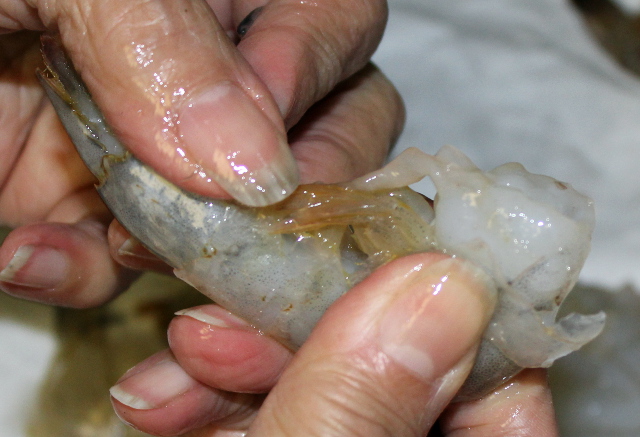
Remove the legs.
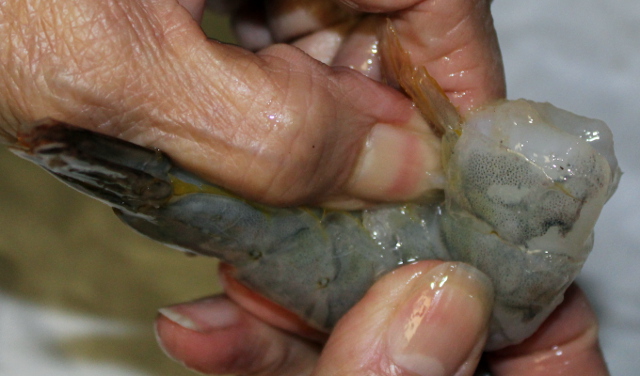
Now peel the shrimp starting where the legs were and work your way around the shrimp.
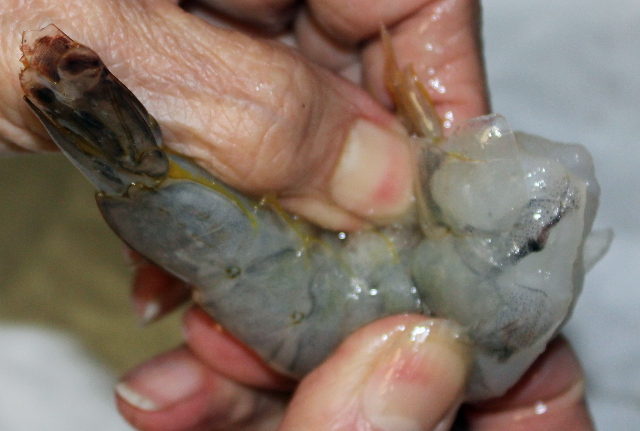
Leave the last section attached, if you like. It makes for a nice presentation.
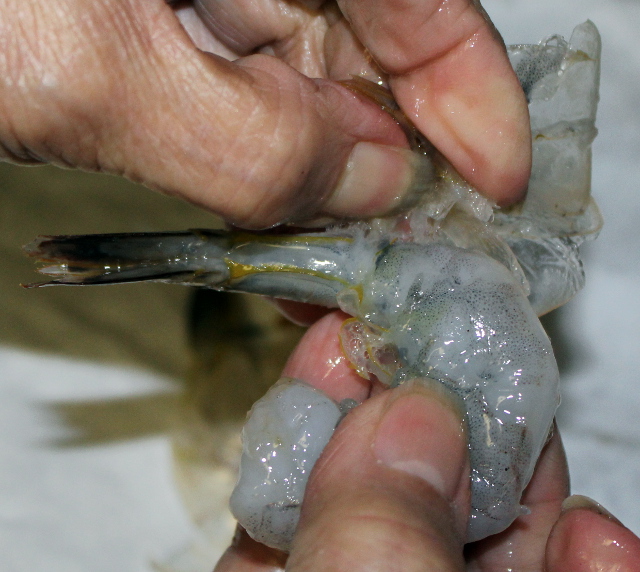
How to de-vein shrimp;
- Hold the shrimp so that the back of the shrimp is facing up. The section where the legs were attached should be facing down.
- Cut a shallow slit in the back of the shrimp with a sharp pairing knife.
- Use a toothpick, or the tip of the knife to remove the vein.
When I prep shrimp, I cut a slit in all the shrimp first. Then I use a toothpick to remove the intestinal track. This is quicker than cutting the slit and removing the vein in one shrimp, then moving on to the next one.
If you use your knife to remove the vein, wipe it off on a paper towel before cutting into any other shrimp.
About Skewers
Grilling shrimp on skewers is much easier than grilling individual shrimp; Instead of turning 30 shrimp, you turn 4-6 skewers, depending on how big the skewers are.
Also, you have to turn the individual shrimp fast, before they dry out or burn. That's hard to do.
Using skewers will give you better shrimp and make your life easier.
Picking the right skewers will also make your life easier...
I prefer flat metal skewers;
- Because they're flat, the shrimp won't spin on the skewers as you turn them.
- They won't burn so there's no need to soak them like you do with bamboo skewers.
- They're reusable; throw 'em in the dishwasher and use them again and again.
If you need to get some metal skewers, avoid wide metal skewers. These are about an inch wide and are too big for shrimp. They're great for meat kabobs, but will tear a little shrimp apart.
Get the smaller, flat metal skewers.
A handle on one end make turning easier. Never turn a hot skewer with your hands though, use fireproof gloves or tongs.
I don't recommend wooden handles either, they will burn!
Also, I would get stainless steel skewers. Most of the skewers on the market are stainless steel so that shouldn't be a problem.
How to Grill Shrimp
Knowing how to grill shrimp is simple if you remember this...
Grill the shrimp over a hot fire for about 2-3 minutes per side.
That's it.
That's the method that we'll use to get tasty, mouthwatering shrimp.
Grilled Shrimp Recipe
In this recipe for how to grill shrimp, you can use chopped parsley or chopped cilantro.
Serve lemons as an accompaniment if you use chopped parsley. Limes if you're using chopped cilantro.
- 2 lbs U15 shrimp (Shrimp that is under 15 shrimp per pound)
- 2 Tbs extra virgin olive oil
- 1-2 Tbs chopped parsley or cilantro
- 3-4 cloves of garlic finely chopped
- Kosher salt and freshly ground pepper to taste.
- Lemons or limes cut in half. (Remove the seeds from the lemons)
- Place the shrimp in a large mixing bowl.
- Add the extra virgin olive oil, parsley or cilantro, garlic and salt and pepper. Toss to combine and coat the shrimp. Let stand for 10-15 minutes.
- Prepare your grill; you want a hot fire. For charcoal, light enough coals so you have a single layer of coals on the charcoal grate, with some areas having a double layer of coals. For a gas grill, turn your burners to medium high to high.
- Thread the shrimp on the skewers: Start by skewering the large end of the shrimp and then through the tail end. The shrimp should hang like a "U" on the skewer. See the photo at the top of the page to see what I mean.
- When your grill is ready, (the coals are covered in white ash, or your gas grill has been preheated for 10-15 minutes) Scrape you grill clean.
- Grill the skewered shrimp for 2-3 minutes per side, or until the shrimp are opaque and slightly firm. Grill the lemon or lime halves for 3-4 minutes while cooking the shrimp.
- Serve at once with the grilled lemons or limes.
- Enjoy!
Now you know how to grill shrimp.
Practice this skill.
Share this newfound knowledge with you friends and family.
Show them that you know how to grill shrimp. You'll have to cook some for them, so they believe you, but hey, that's what you do.
Happy Grilling...
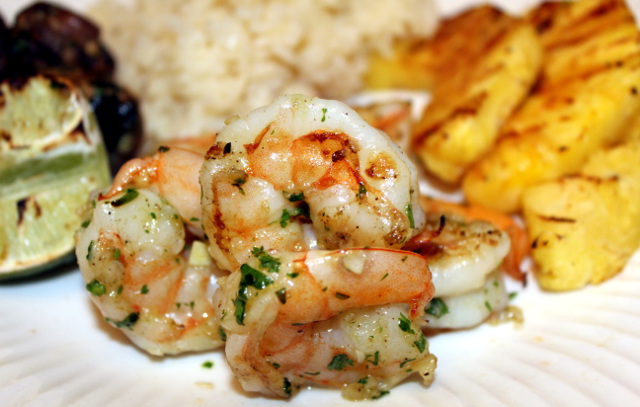 Grilled Shrimp with Rice, Beans and Grilled Pineapple
Grilled Shrimp with Rice, Beans and Grilled Pineapple